One of the Best Chefs in the World Now Has a Restaurant Inside This Cancun, Mexico, Water Park — and I Tried It
Peruvian chef Virgilio Martinez shows off his skills with ingredients from the Yucatán in a very unexpected place: Cancun, Mexico's Xcaret Water Park.
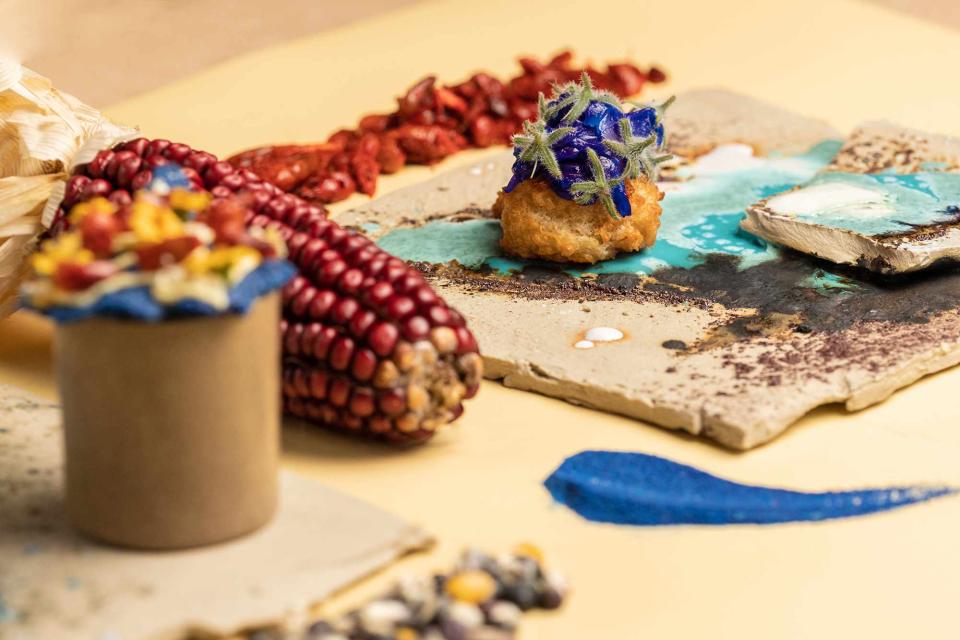
Erik Ruiz/Courtesy of Xcaret Hotels
Cured in seaweed, an order of tuna crudo arrives topped with a green “sea jelly” rendered from the fish’s head. Draping the dish is something luscious; it looks and tastes like scrambled duck egg, but it's actually ant larvae. Corn fritters wear a neon squiggle of blue spirulina, a sea algae. The gelée garnishing the chocolate pudding was made from the pulp of the cacao pod, an ingredient that's typically discarded, and a tea brewed from cacao leaves accompanies it.
It was a characteristically inventive meal by Virgilio Martinez, the chef designated the second-best in the world and who is ever aiming for "fine dining that has meaning.” But I enjoyed his delicious fare not in Lima, at his flagship restaurant Central, nor in the Andean highlands, where his culinary laboratory Mil is located. I was instead dining in a Disney-like development built around a theme park.
La Casa de la Playa, a luxury hotel on Mexico's Riviera Maya, opened in December 2021 at a natural water park called Xcaret. The Disney World of the Yucatán, Xcaret is a sprawling development that includes two 900-room hotels; water, cultural, and adventure parks; the world’s busiest zip line; and now La Casa de la Playa, a 63-room property where my 1,065-square-foot Wellness Ocean View Suite featured a balcony infinity pool, a lava-stone jacuzzi, an in-wall jellyfish tank, and butler service.
In addition to a chocolateria, tequila bar, and wine cave (all open 24/7 for self-service indulgence), La Casa de la Playa’s culinary offerings include restaurants by noted Mexican chefs Martha Ortiz and the Rivera-Río Brothers. But the big opening this winter was Martinez’s Estero, a Mexico-meets-Peru endeavor where the all-day dining culminates in a seven-course prix fixe meal, at which I devoured ant eggs and a tuna-head gelée.
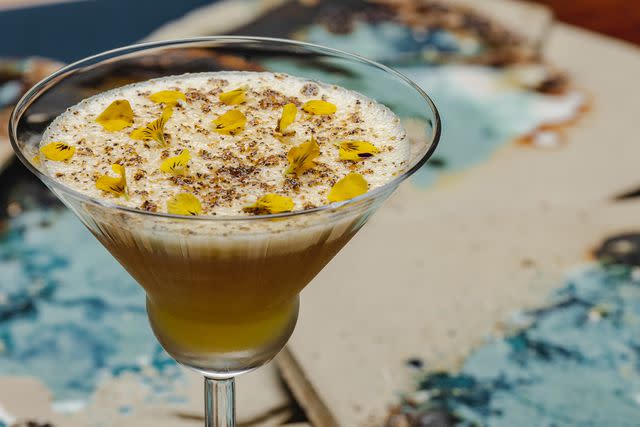
Erik Ruiz/Courtesy of Xcaret Hotels
“I brought in what I've been working on in Peru, applying those techniques and ways of seeing,” Martinez told me before I ate at Estero's inaugural dinner service. “But we're taking inspiration from Mexican ingredients.” Puréed local squash, for instance, was coated with what looked like a thick layer of ash. It was an assemblage of dried spices that recalled a Oaxacan mole: black and pink pepper, coriander seed, sesame, cumin, star anise, cinnamon, and black recado — “a traditional spice from the south of Mexico,” as Martinez described it. “Using endemic products and presenting them in a fine way is putting a value on and preserving the culture. We need to innovate in order to keep traditions alive.”
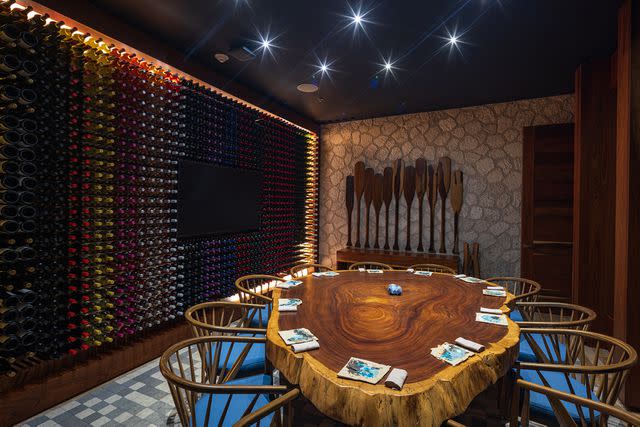
Erik Ruiz/Courtesy of Xcaret Hotels

Erik Ruiz/Courtesy of Xcaret Hotels
Designed by the chef, Estero’s unique plateware — thick, contoured stone blotched with colored glass — abets the chef’s mission. Though Martinez told me the ceramics were “inspired by the colors and shapes of the Peruvian landscape,” they’re so evocative that they help tell a more local story. Waygu tartare with caviar and potato purée is a more generic dish by Martinez, but here he flavors the potatoes with the Mexican epazote and hides the dish inside in a spherical bowl with a shimmering, blue interior glaze — it evokes the Yucatán’s many cenotes, waterlogged caverns that are sacred to the Maya.
Waygu and caviar may be omnipresent at haute dining rooms all over the globe, but Martinez said international tastes can to influence his cooking organically, thanks to the diversity of his home country. “Apart from being one of the most biodiverse territories in the world, Peru is also a melting pot of cultures, from the ones that arrived in the past centuries — the Japanese and Chinese, the Spaniards and Africans — to the local communities from the Andes and the Amazon. All this diversity influences the way I create my dishes,” he said. A puffed seaweed cracker topped with crunchy, dried river shrimp tasted like a Japanese snack. There was pork hiding beneath the puréed squash, and it had been braised in the sauce for lomo saltado, a Peruvian-Chinese stir-fried steak.
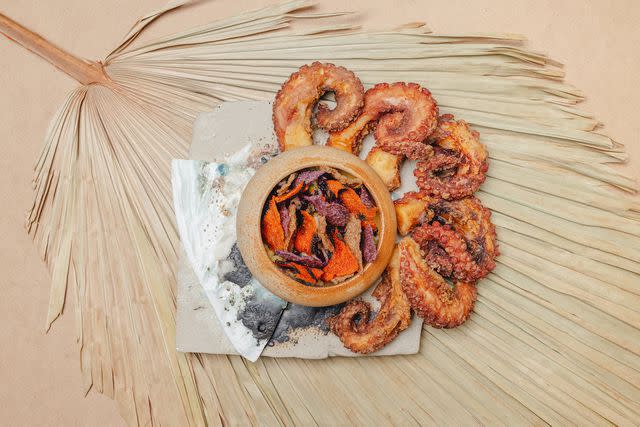
Erik Ruiz/Courtesy of Xcaret Hotels
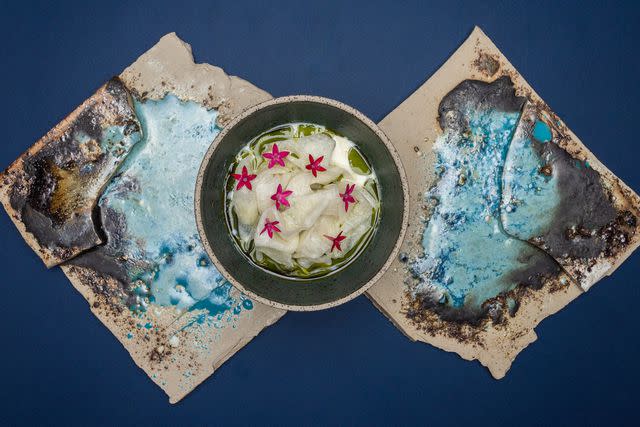
Erik Ruiz/Courtesy of Xcaret Hotels
Martinez’s mission is to preserve both biological and cultural diversity. Items like the cacao leaf tea derive from the fact that the chef hates waste. “When I was working in the past for French chefs, the idea was looking for perfection. We threw away lots of food. But coming from a society where people are starving, for me, it was like, 'Why?' We focus on sharing what nature gives us and try to be creative to use it in different ways.”
Despite the food’s flamboyance, there’s a humility to that approach that’s a relief for diners. Interrupted by wood-clad walls that might hide support beams, Estero’s basement space is humble. Much of it is taken up by the open kitchen, but the chefs aren’t putting on a show. They’re working, with Martinez quietly instructing them, his demeanor serious but calm. The floor staff exhibits none of the “yes, chef”-style hero worship found elsewhere. Instead, they just seem happy to be working for the guy. All of this makes a fascinating dining experience feel relaxing, too.

Erik Ruiz/Courtesy of Xcaret Hotels
“What was the reason for fine dining? It is not about luxury anymore,” Martinez said. “You go to a restaurant that has a boring, four-hour tasting menu, or you go to a restaurant that makes you think. That’s what I want: a restaurant that makes you think.”
Exacting in his execution, Martinez restlessly reaches for ideas. “I was in the kitchen just now ready to make changes to 50 percent of what we are doing,” Martinez told me just before service. But if ideas drive him, the end result is delight. For a quick lunch on my balcony one afternoon, I ordered one of the chef’s suggestions from the in-room dining menu: lobster, grouper, sea grapes, seaweed, and avocado dressed in subtle, silky tigre de leche. It was the most delicious and delicate ceviche I’ve ever eaten. And it was the hallmark of a Peruvian master who’s enjoying unleashing his talents on the fresh ingredients of the Yucatán coast.
For more Travel & Leisure news, make sure to sign up for our newsletter!
Read the original article on Travel & Leisure.

